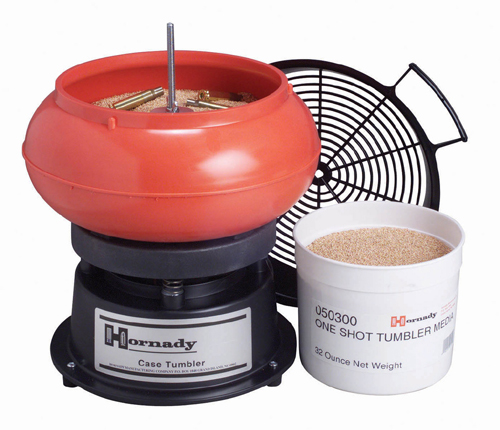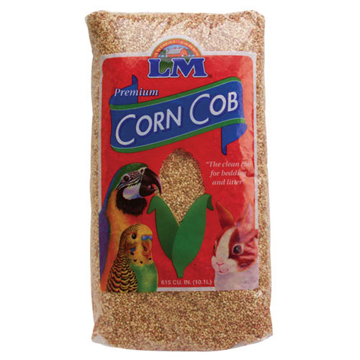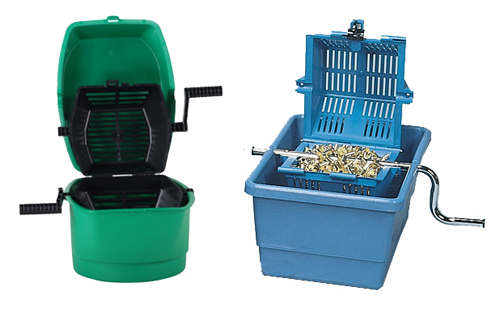Cleaning Cases - Part 1: Dry Tumbling
The only part of a cartridge that can be reused is the spent brass case. In fact, much of the savings realized by reloading comes from your ability to reuse the case several times. The first step in preparing a case for reuse is cleaning it.
You need to clean the cases so that they can be easily inspected and will not transfer harmful debris to your dies. There are many ways to clean your cases, but this article will concentrate on the most common method: Dry tumbling.
Dry tumbling
Technically, a dry tumbler is a vibratory bowl cleaner. This device consists of a covered bowl-shaped hopper
with an electric motor mounted to the bottom. The motor has an offset weight installed on its shaft. When
the motor is on, the offset weight causes the motor and bowl to vibrate. The motor does not spin the bowl - its
sole purpose is to create vibration. The bowl/motor is connected to the base through springs so the unit will
stay put, and not 'walk' across the room.
The bowl itself is shaped like an upside-down Bundt cake pan, with a central pedestal and rounded bottom. The shape of the bowl is important - it's what actually enables the cleaning process. The vibration combined with the shape of the bowl sets up a circular motion that causes the cases to constantly flow through the media, moving up the sides of the bowl, across the top of the media, and down along the center pedestal. While the cases move, they rub against the media, each other, and the sides of the bowl, becoming clean in the process.

The tumbler is filled to about 2/3 capacity with dry media, filled the rest of the way with unsized dirty cases sorted by caliber, and then run for several hours to clean the cases. It is not necessary to decap the brass before tumbling, as dry tumbling will not clean the primer pockets anyway (or even the insides of the cases). Once cleaned, the cases are separated from the media, and can be reloaded immediately.
Dry Tumbler Media
The two types of media most often used to clean cases are corn cob and walnut shell. Corn cob will produce a
high gloss finish on the cases but will take longer than walnut, which leaves the cases with more of a satin finish.
Corn cob media for tumbling is not made from whole ground corn cobs. A corn cob consists of three parts,
the pith, the chaff, and the woody ring. For tumbler media, the pith and chaff are removed, and the woody ring
is ground up and screened for grit size. Corn cob tumbler media is the same as corn cob media for (sand)
blasting. It is hard and aggressive enough to clean the brass without damaging the cases.

Do not be tempted to use inexpensive pet bedding or kitty litter made from ground corn cobs as these products are made from whole ground cobs (bot screened for grit size) and will result in a gummy mess in your tumbler and clogged bottleneck rifle cases. A grit size of 10/14 will clean efficiently and be easy to separate from the cases.
Ground walnut shell is more aggressive than corn cob so it cleans faster. Unlike corn cob, ground walnut shell pet bedding makes an effective tumbler media. This is sold in pet stores for use in reptile enclosures. Both media types are available from sand blast supply houses in 40-50 pound bags. The media is inexpensive - it usually costs about $.50/pound.
The media does not last forever, and should be replaced when it wears out. Worn out media will be a brownish-black color and will no longer clean as effectively as new media. If you notice that it's taking longer to get the cases clean, it's probably time to replace your media. Media will usually last from 10 to 20 runs, possibly more if you run fewer cases or cases that are cleaner to begin with.
Media Additives
Polishing compounds can be added to the media to assist in cleaning and help to keep the dust down. Liquid
polishing compounds are available from reloading supply houses and tumbler manufacturers. NuFinish liquid
car polish (in the orange bottle) is also a very effective polish additive. Add about 1/8 cup of liquid polish
to the media (or up to 1/4 cup for large tumblers) and allow the tumbler to run without cases for about 10 minutes to
distribute the polish.
To help the media stay cleaner longer, some reloaders add used dryer sheets cut into strips to the media. These are discarded and replaced at the end of each run, taking a good bit of powder/primer residue with them.
Media Separator
When you're finished tumbling, you must separate your clean cases from the media. This can be accomplished
using a colander and bucket, or with a device called a media separator. A media separator is a hand-cranked
plastic cage in a tub (with or without a cover). The brass and media are dumped from the tumbler into the
media separator cage, and the cage is rotated by hand. The slots in the cage are small enough to contain the
cases, but small enough to let the media flow out. After about 20 seconds, the media will be fully separated
from the cases.

media, and is good for your health (Left - RCBS, Right - Dillon)
Not only is a media separator faster than the colander-and-bucket method, it's also better for your long term health.
Safety and Hygiene
In addition to grit, debris, and tarnish, the tumbler removes powder and primer residue from your cases. This
residue ends up in the media. Primer residue contains a poisonous chemical called Lead Styphnate which can
contribute to elevated blood lead levels. The best way to avoid exposure to this toxin is to handle the media
(and dirty cases) as little as possible. A media separator can help with this.
Lead Styphnate can also be inhaled, so you should use a polishing additive to keep down the dust. Since the concentration of toxins in the media increases each time you use it, frequent media changes can also help to reduce exposure.
Final Thoughts
Always sort the brass by caliber before tumbling. If you do not, smaller cases will become lodged inside larger
cases, with bits of media in between, requiring pliers to pull them apart. You will spend much more time dealing
with stuck cases after the fact than you will sorting before you tumble.
Research the capacity of tumblers before you buy, and select one that most closely meets the size of the batches that you will run. Bigger is not necessarily better. Tumblers clean most efficiently with a full load of cases. A small handful of cases in a large tumbler may not get clean even after many hours of tumbling.